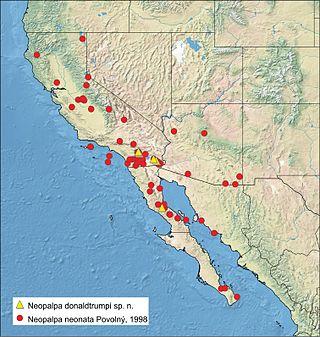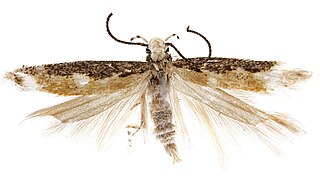
The Gelechiidae are a family of moths commonly referred to as twirler moths or gelechiid moths. They are the namesake family of the huge and little-studied superfamily Gelechioidea, and the family's taxonomy has been subject to considerable dispute. These are generally very small moths with narrow, fringed wings. The larvae of most species feed internally on various parts of their host plants, sometimes causing galls. Douglas-fir (Pseudotsuga) is a host plant common to many species of the family, particularly of the genus Chionodes, which as a result is more diverse in North America than usual for Gelechioidea.

Athrips is a genus of moths in the family Gelechiidae.

Caryocolum is a genus of moths in the family Gelechiidae.
Ephysteris is a genus of the twirler moth family (Gelechiidae). Among these, it is assigned to tribe Gnorimoschemini of the subfamily Gelechiinae. Even though it is a rather diverse and widespread group, most of these small and inconspicuous moths were overlooked by scientists until the early 20th century. Almost 90 species are known today but new ones are still being discovered.

Gnorimoschema is a genus of moths in the family Gelechiidae.

Kiwaia is a genus of moths in the family Gelechiidae. Two subgenera are currently recognised, (i) the nominotypical subgenus with 25 species from New Zealand, and (ii) subgenus Empista with 4 species from the Palaearctic Region.
Microlechia is a genus of moths in the family Gelechiidae.

Neopalpa is a genus of moths in the family Gelechiidae. They are found in California, Arizona, and northern Mexico. Neopalpa is classified in the tribe Gnorimoschemini and is most closely related to the genera Ochrodia and Ephysteris.

Phthorimaea is a genus of moths in the family Gelechiidae. Species include the potato tuber moth, Phthorimaea operculella.

Scrobipalpa is a genus of moths in the family Gelechiidae. Euscrobipalpa has sometimes been treated as a distinct subgenus, or even as a full genus, but is generally no longer recognised as valid, following Ponomarenko & Park (2007).
Scrobipalpomima is a genus of moths in the family Gelechiidae.
Scrobitasta is a genus of moth in the family Gelechiidae. It contains the species Scrobitasta varians, which is found in Argentina.

Gelechiinae is a subfamily of moths in the family Gelechiidae. It was described by Henry Tibbats Stainton in 1854.

Neopalpa neonata is a species of moth in the family Gelechiidae. It is found in southwest of North America, where it has been recorded throughout most of California, Arizona and the most western regions of Northern Mexico.
Nevadopalpa maculata is a moth in the family Gelechiidae. It was described by Povolný in 1999. It is found in North America, where it has been recorded from California.
Nevadopalpa albula is a moth in the family Gelechiidae. It was described by Povolný in 1998. It is found in North America, where it has been recorded from California.
Nevadopalpa striata is a moth in the family Gelechiidae. It was described by Povolný in 1998. It is found in North America, where it has been recorded from California.

Neopalpa donaldtrumpi is a moth species of the genus Neopalpa occurring in Southern California and Northern Mexico. It was described in 2017 by Iranian-Canadian scientist Vazrick Nazari. Known for its yellowish-white head scales being reminiscent of Donald Trump's hair, the moth was given its name because Nazari stated that he wanted "to bring wider public attention to the need to continue protecting fragile habitats in the US that still contain many undescribed species."









